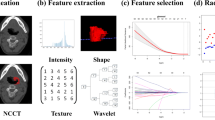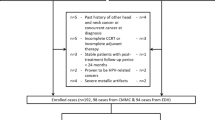Abstract
Objective
To explore whether radiomics features extracted from pre-treatment magnetic resonance imaging (MRI) can predict the overall survival (OS) in patients with hypopharyngeal squamous cell carcinoma.
Methods
A total of 190 patients with hypopharyngeal squamous cell carcinoma were eligibly enrolled from two institutions. Radiomics features were extracted from contrast-enhanced axial T1-weighted (CE-T1WI) sequence. The least absolute shrinkage selection operator (LASSO) algorithm was applied to establish a radiomics score correlated with OS. Multivariate logistic regression analysis was applied to determine the independent risk factors, which was combined with radiomics score to build the final radiomics nomogram.
Results
A radiomics score with 6 CE-T1WI features for OS prediction was constructed and validated; its integration with specific clinicopathologic factors (N stage) showed a better prediction performance in the training, internal validation, and external validation cohorts (C-index 0.78, 0.75, and 0.75). Calibration curves determined a good agreement between the predicted and actual overall survival.
Conclusions
The radiomics-clinical nomogram and radiomics score might be non-invasive and reliable methods for the risk stratification in patients with hypopharyngeal squamous cell carcinoma.
Key Points
• An MRI-based radiomics model was constructed to evaluate of OS in patients with hypopharyngeal squamous cell carcinoma.
• A radiomics-clinical nomogram that combined radiomics features and clinical characteristics was established.
• Multi-cohort study validated the predictive performance of the radiomics-clinical nomogram to stratify patients with high risk in clinical practice.



Similar content being viewed by others
Abbreviations
- CE-T1WI:
-
Contrast-enhanced T1-weighted sequence
- C-index:
-
Harrell’s concordance index
- CT:
-
Computed tomography
- HNC:
-
Head and neck cancer
- LASSO:
-
The least absolute shrinkage and selection operator
- LMR:
-
Lymphocyte-to-monocyte ratio
- MRI:
-
Magnetic resonance imaging
- NLR:
-
Neutrophil-to-lymphocyte ratio
- OS:
-
Overall survival
- PACS:
-
Picture Archiving and Communication System
- PLR:
-
Platelet-to-lymphocyte ratio
- ROI:
-
Region of interest
- TNM:
-
The Tumor, Node, Metastasis staging system
References
Bray F, Ferlay J, Soerjomataram I, Siegel RL, Torre LA, Jemal A (2018) Global cancer statistics 2018: GLOBOCAN estimates of incidence and mortality worldwide for 36 cancers in 185 countries. CA Cancer J Clin 68:394–424
Chow LQM (2020) Head and Neck Cancer. N Engl J Med 382:60–72
Machiels JP, Rene Leemans C, Golusinski W et al (2020) Squamous cell carcinoma of the oral cavity, larynx, oropharynx and hypopharynx: EHNS-ESMO-ESTRO Clinical Practice Guidelines for diagnosis, treatment and follow-up. Ann Oncol 31:1462–1475
Pfister DG, Spencer S, Adelstein D et al (2020) Head and Neck Cancers, Version 2.2020, NCCN Clinical Practice Guidelines in Oncology. J Natl Compr Canc Netw 18:873–898
Ho AS, Kim S, Tighiouart M et al (2018) Association of Quantitative Metastatic Lymph Node Burden With Survival in Hypopharyngeal and Laryngeal Cancer. JAMA Oncol 4:985–989
Lambin P, Leijenaar RTH, Deist TM et al (2017) Radiomics: the bridge between medical imaging and personalized medicine. Nat Rev Clin Oncol 14:749–762
Bi WL, Hosny A, Schabath MB et al (2019) Artificial intelligence in cancer imaging: Clinical challenges and applications. CA Cancer J Clin 69:127–157
Conti A, Duggento A, Indovina I, Guerrisi M, Toschi N (2021) Radiomics in breast cancer classification and prediction. Semin Cancer Biol 72:238–250
** IL, Zhao Y, Wang R et al (2020) Deep Learning to Distinguish Benign from Malignant Renal Lesions Based on Routine MR Imaging. Clin Cancer Res 26:1944–1952
Dong D, Tang L, Li ZY et al (2019) Development and validation of an individualized nomogram to identify occult peritoneal metastasis in patients with advanced gastric cancer. Ann Oncol 30:431–438
Huang YQ, Liang CH, He L et al (2016) Development and Validation of a Radiomics Nomogram for Preoperative Prediction of Lymph Node Metastasis in Colorectal Cancer. J Clin Oncol 34:2157–2164
Liu Z, Li Z, Qu J et al (2019) Radiomics of Multiparametric MRI for Pretreatment Prediction of Pathologic Complete Response to Neoadjuvant Chemotherapy in Breast Cancer: A Multicenter Study. Clin Cancer Res 25:3538–3547
Sun R, Limkin EJ, Vakalopoulou M et al (2018) A radiomics approach to assess tumour-infiltrating CD8 cells and response to anti-PD-1 or anti-PD-L1 immunotherapy: an imaging biomarker, retrospective multicohort study. Lancet Oncol 19:1180–1191
Kim S, Shin J, Kim DY, Choi GH, Kim MJ, Choi JY (2019) Radiomics on Gadoxetic Acid-Enhanced Magnetic Resonance Imaging for Prediction of Postoperative Early and Late Recurrence of Single Hepatocellular Carcinoma. Clin Cancer Res 25:3847–3855
Park H, Lim Y, Ko ES et al (2018) Radiomics Signature on Magnetic Resonance Imaging: Association with Disease-Free Survival in Patients with Invasive Breast Cancer. Clin Cancer Res 24:4705–4714
Mo X, Wu X, Dong D et al (2020) Prognostic value of the radiomics-based model in progression-free survival of hypopharyngeal cancer treated with chemoradiation. Eur Radiol 30:833–843
Zhang B, Tian J, Dong D et al (2017) Radiomics Features of Multiparametric MRI as Novel Prognostic Factors in Advanced Nasopharyngeal Carcinoma. Clin Cancer Res 23:4259–4269
**e C, Du R, Ho JW et al (2020) Effect of machine learning re-sampling techniques for imbalanced datasets in (18)F-FDG PET-based radiomics model on prognostication performance in cohorts of head and neck cancer patients. Eur J Nucl Med Mol Imaging 47:2826–2835
Cavalieri S, De Cecco L, Brakenhoff RH et al (2021) Development of a multiomics database for personalized prognostic forecasting in head and neck cancer: The Big Data to Decide EU Project. Head Neck 43:601–612
Hsu CY, Lin SM, Ming Tsang N et al (2020) Magnetic resonance imaging-derived radiomic signature predicts locoregional failure after organ preservation therapy in patients with hypopharyngeal squamous cell carcinoma. Clin Transl Radiat Oncol 25:1–9
Nachmani A, Schurr R, Joskowicz L, Mezer AA (2019) The effect of motion correction interpolation on quantitative T1 map** with MRI. Med Image Anal 52:119–127
Zhou M, Scott J, Chaudhury B et al (2018) Radiomics in Brain Tumor: Image Assessment, Quantitative Feature Descriptors, and Machine-Learning Approaches. AJNR Am J Neuroradiol 39:208–216
Beig N, Singh S, Bera K et al (2021) Sexually dimorphic radiogenomic models identify distinct imaging and biological pathways that are prognostic of overall survival in glioblastoma. Neuro Oncol 23:251–263
Welch ML, McIntosh C, Haibe-Kains B et al (2019) Vulnerabilities of radiomic signature development: The need for safeguards. Radiother Oncol 130:2–9
Zhang J, Yao K, Liu P et al (2020) A radiomics model for preoperative prediction of brain invasion in meningioma non-invasively based on MRI: A multicentre study. EBioMedicine 58:102933
Rizzo S, Botta F, Raimondi S et al (2018) Radiomics of high-grade serous ovarian cancer: association between quantitative CT features, residual tumour and disease progression within 12 months. Eur Radiol 28:4849–4859
Zhou J, Lu J, Gao C et al (2020) Predicting the response to neoadjuvant chemotherapy for breast cancer: wavelet transforming radiomics in MRI. BMC Cancer 20:100
Su C, Jiang J, Zhang S et al (2019) Radiomics based on multicontrast MRI can precisely differentiate among glioma subtypes and predict tumour-proliferative behaviour. Eur Radiol 29:1986–1996
Dong D, Fang MJ, Tang L et al (2020) Deep learning radiomic nomogram can predict the number of lymph node metastasis in locally advanced gastric cancer: an international multicenter study. Ann Oncol 31:912–920
Dok R, Glorieux M, Holacka K, Bamps M, Nuyts S (2017) Dual role for p16 in the metastasis process of HPV positive head and neck cancers. Mol Cancer 16:113
Chung EJ, Kim GW, Cho BK, Park HS, Rho YS (2016) Pattern of lymph node metastasis in hypopharyngeal squamous cell carcinoma and indications for level VI lymph node dissection. Head Neck 38(Suppl 1):E1969-1973
**e J, Li B, Min X et al (2020) Prediction of Pathological Upgrading at Radical Prostatectomy in Prostate Cancer Eligible for Active Surveillance: A Texture Features and Machine Learning-Based Analysis of Apparent Diffusion Coefficient Maps. Front Oncol 10:604266
Acknowledgements
This study was supported by the National Natural Science Foundation of China (Nos. 82073009, 81974424, 81874133, 81773243, 81772903 and 81602684), the National Key Research and Development Program of China (2020YFC1316900, 2020YFC1316901), the Natural Science Foundation of Hunan Province (Nos. 2019JJ40481, 2019JJ50944, 2018JJ2630 and 2017JJ3488), the Huxiang Young Talent Project (No. 2018RS3024) and Young Scientist Research Fund of **angya Hospital (No. 2018Q019).
Funding
This study was supported by the National Natural Science Foundation of China (Nos. 82073009, 81974424, 81874133, 81773243, 81772903 and 81602684), the National Key Research and Development Program of China (2020YFC1316900, 2020YFC1316901), the Natural Science Foundation of Hunan Province (Nos. 2019JJ40481, 2019JJ50944, 2018JJ2630 and 2017JJ3488), the Huxiang Young Talent Project (No. 2018RS3024) and Young Scientist Research Fund of **angya Hospital (No. 2018Q019).
Author information
Authors and Affiliations
Corresponding authors
Ethics declarations
Guarantor
The guarantor of this publication is Yuanzheng Qiu.
Conflict of interest
The authors of this manuscript declare no relationships with any companies, whose products or services may be related to the subject matter of the article.
Statistics and biometry
One of the authors (Yan Gao) has significant statistical expertise.
Informed consent
Written informed consent was waved by the Institutional Review Board.
Ethical approval
Institutional Review Board approval was obtained.
Methodology
-
retrospective
-
diagnostic or prognostic study
-
performed at multiple institution
Additional information
Publisher’s note
Springer Nature remains neutral with regard to jurisdictional claims in published maps and institutional affiliations.
Supplementary Information
Below is the link to the electronic supplementary material.
Rights and permissions
About this article
Cite this article
Chen, J., Lu, S., Mao, Y. et al. An MRI-based radiomics-clinical nomogram for the overall survival prediction in patients with hypopharyngeal squamous cell carcinoma: a multi-cohort study. Eur Radiol 32, 1548–1557 (2022). https://doi.org/10.1007/s00330-021-08292-z
Received:
Revised:
Accepted:
Published:
Issue Date:
DOI: https://doi.org/10.1007/s00330-021-08292-z




